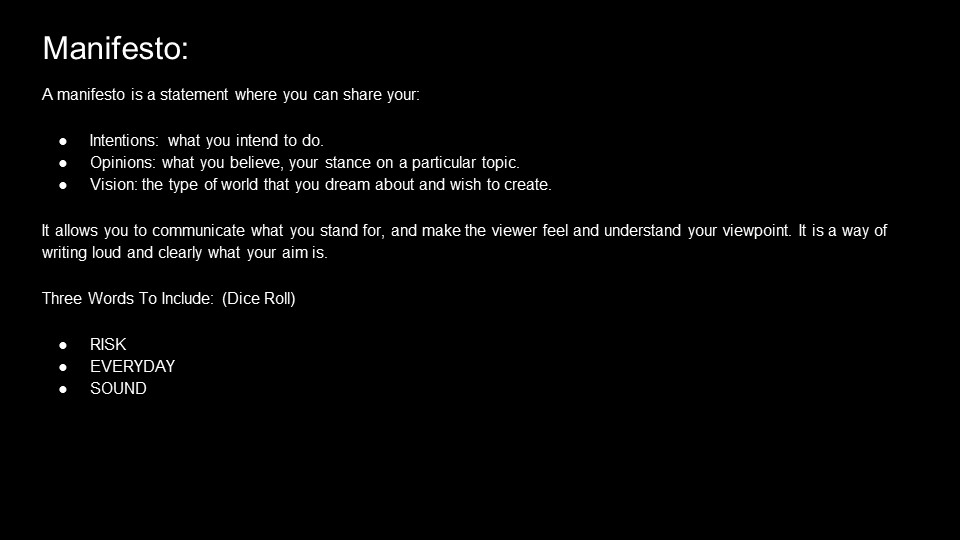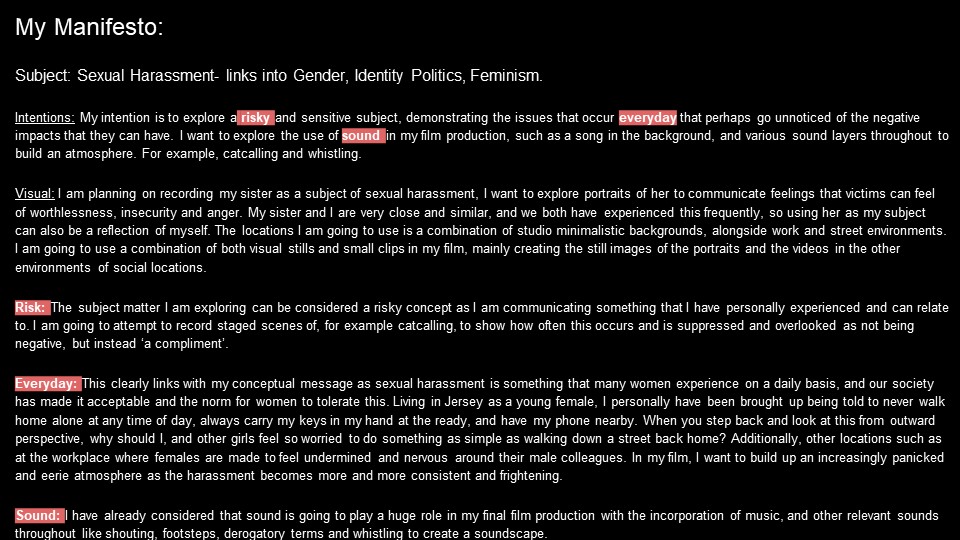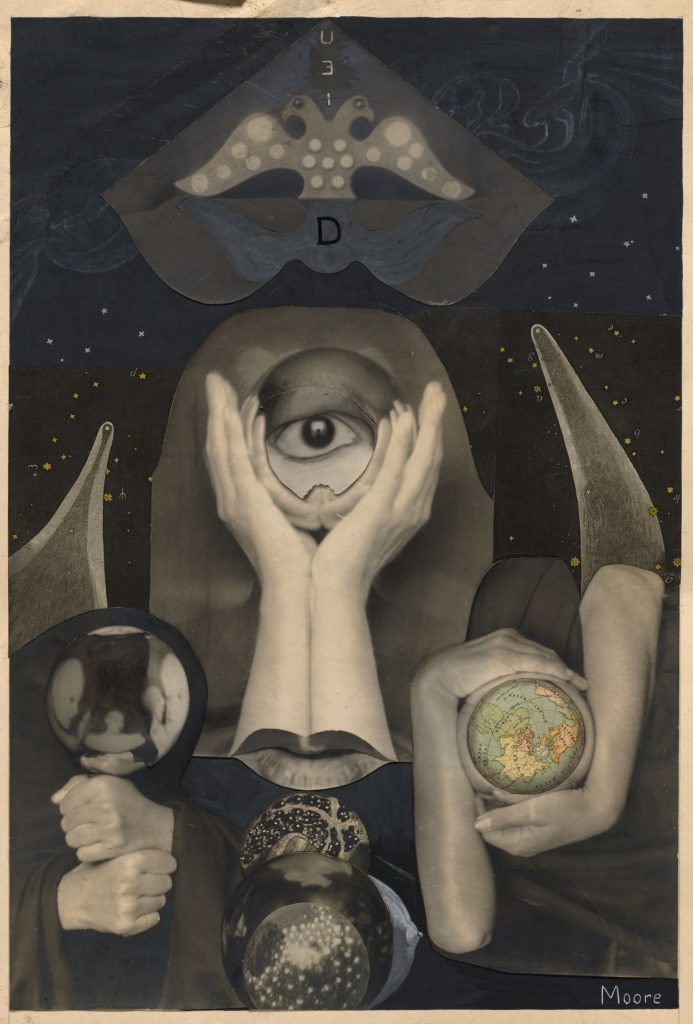Monthly Archives: October 2020
Filters
MANIFESTO
THEME: Rebelling against the societal expectations towards women.
SUBJECT: Focusing mainly on personal identity as well as incorporating politics in the sense of how the capitalistic government controls what we are influenced by.
INTENTIONS: In groups, we carried out a dice roll task. We were given three die and asked to roll them all at once. Each dice was linked to a set of words which corresponded with the number on the die. After the dice were rolled, we were left with the following three words: RISK, CHANCE and ABSURD. These were to be incorporated into our manifesto.
VISUALS: Inspiration from O’Donnell on her process of ‘performing’ for the camera. Additionally, our group was inspired by how O’Donnell portrayed the conflict between her and her personal identity.
SOUND: A reading of the poem ‘The Jabberwocky’ by Lewis Carroll. Although not from the Dada era, it can be considered as a nonsense poem. The subject within the poem is shown to have rebelled against the advice and warnings about the creature from his father and is later praised for this rebellion. We felt as though it would successfully tie in with our theme as the subject of our film is planning to rebel against the norms of society. We were hoping that the Jabberwocky would be a metaphor for society and the lack of control people have over their identity due to this.
TITLE ideas: Opening the third eye, The art of unlearning, Reconditioning the mind,
‘An open third eye allows you to take in light and details that you would otherwise miss, and this can be intense or overwhelming at first. Feeling like you are changing on a fundamental level, even if you struggle to put it into words.’
What is a manifesto?
In art: a manifesto is a public declaration of the intentions, motives, or views of an artist or artistic movement.
Additionally, we were looking to incorporate the idea of ‘Breaking the rules of reality’. This is present in our manifesto below.
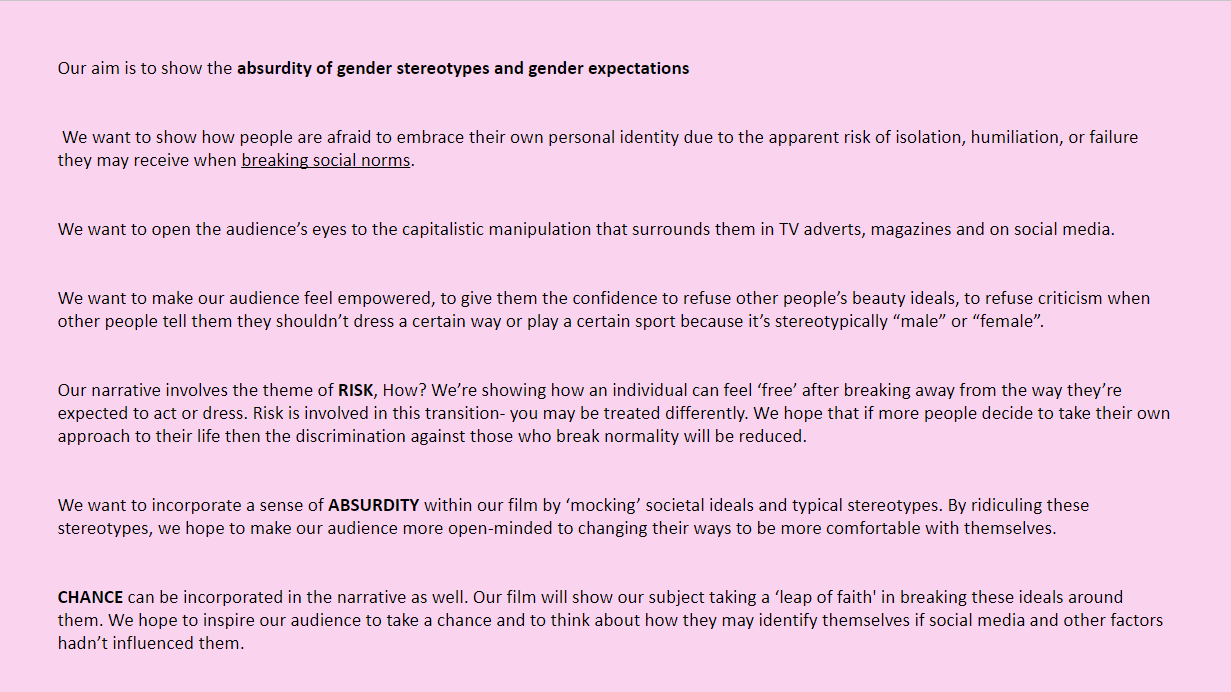
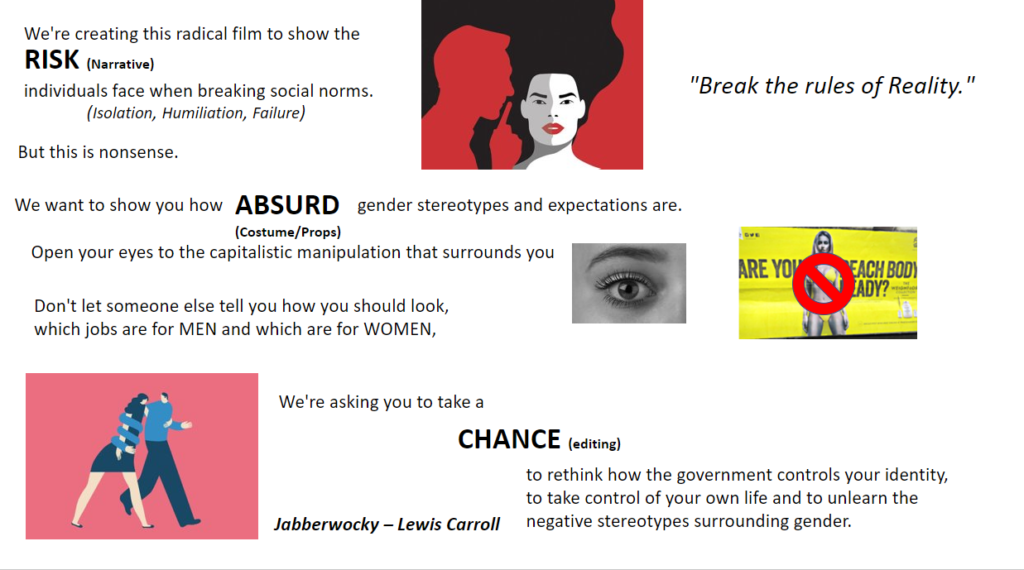
Narrative (Risk)
Events throughout the film depict the risks being taken and the final outcome of the film amplifies this risk / resolves it.
Mise-en-scene (Absurdity)
Costumes and props will emphasize the absurdity surrounding gender roles and stereotypes.
Editing (Chance)
We want to give the audience a chance to reconsider their beliefs surrounding gender and identity. Especially we want to look at the idea of unlearning negative gender roles and identity expectations through editing such as reversed scenes.
film MANIFESTO

Dadaism
Dadaism was an avant-garde movement established in response to the horrors of World War One. It was an anti-art movemtn which aimed to mark the disillusionment and absurdity of hte times they were living in. The dadaism movement came in multiple forms, ranging from art and music to fashion and poetry.
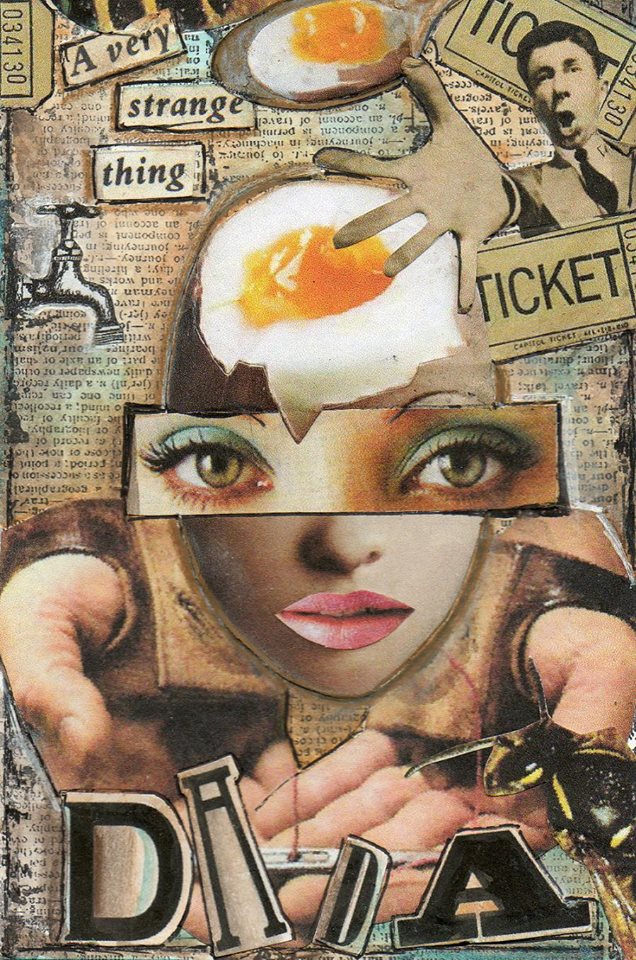
The artwork that came from this movement is often described as having strong political tones, as well as being ‘absurd’ ‘unconventional’ and ’empty art’.
A few founding principles of dadaism are:
- Humour
- Spontaneity
- Paradoxical (having contradictory features)
- Irrationalism
- Artistic freedom
Dadaism aimed to show the faults in society’s idea of progress. The Dada movement rejected capitalism and authoritarianism. Marcel Duchamp was the most prominent artist from this movement who exemplified these attitudes in his work.
Marcel Duchamp
Duchamp was one of the pioneers of the Dada movement. He changed the view that art had to be based on an artefact or something physical. Dadaism changed ‘art’ to become a concept by destroying the very foundations it was established on.
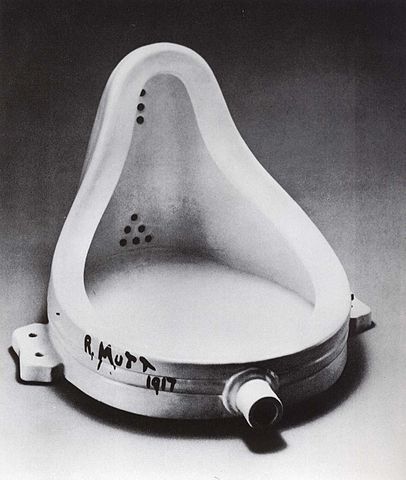
In a bold attempt to destroy the definition of art, he sought out to submit an outrageous art entry to an exhibition by the Society of Independent Artists in New York, 1917. This particular exhibition had rules that explicitly stated that all works submitted would be exhibited. With having 2500 submitted pieces, the exhibition was a massive event, and attracted the attention Duchamp wanted.
Whilst looking for his perfect exhibit, Duchamp came across a retail store which had a display of sanitary ware. He then purchased a standard ,white porcelain urinal and took it to his studio where he signed it with the pseudonym ‘R.Mutt’ and named the piece ‘Fountain’. Ironically, it is now the most memorable piece from the exhibit as its nonsensical nature outraged the exhibitors, who removed it from display after a short while.
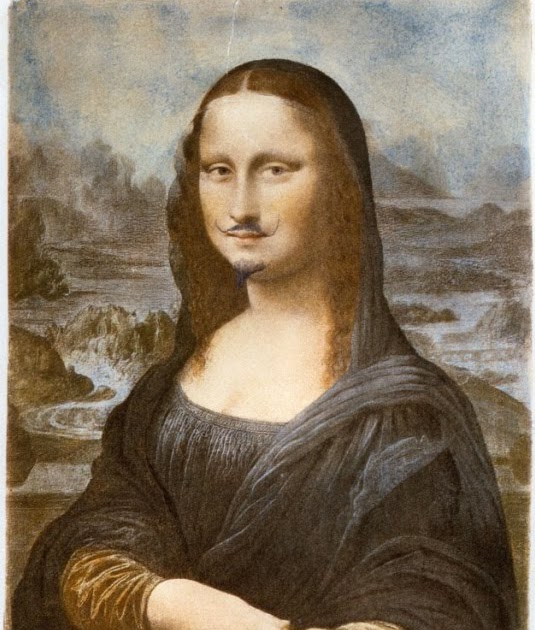
L.H.O.O.Q. was another one of Duchamp’s most influential pieces. Labelled as a ‘cheap reproduction’ of the world renowned ‘Mona Lisa’, Duchamp defaced the subject with a comical moustache and goatee. Some interpret this as the conversion of a woman to man, linking it to the idea that Leonardo da Vinci’s sexuality was directed more favourably to men. Others argue that it was Duchamp’s rebellion against the traditional nature of art.
Additionally, the name itself, ‘L.H.O.O.Q.’ has been interpreted as a pun. It is argued that the letters sound similar to the french phrase “Elle a chaud au cul” which has multiple explicit translations. The letters have become words which translate to a devaluing male comment on the dignified woman depicted in the original photo.
Tristan Tzara
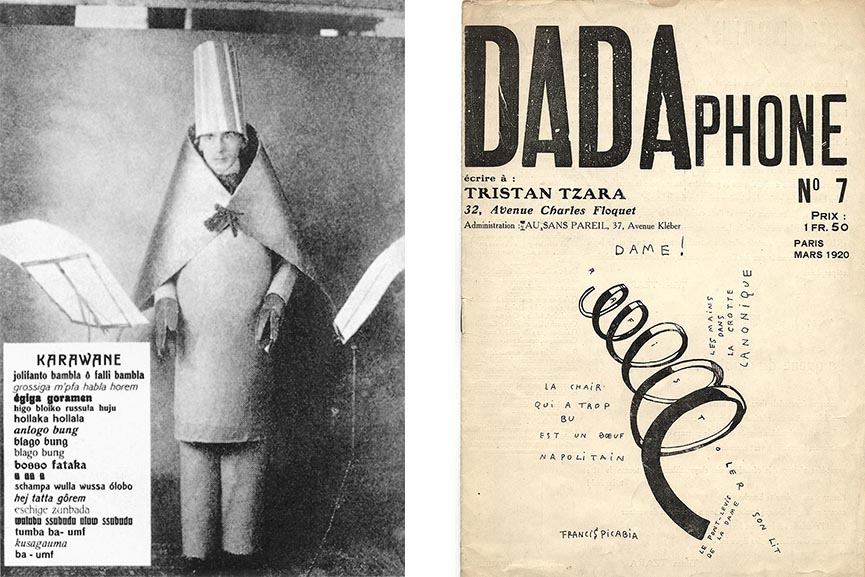
Tzara was a Romanian-born French poet known mainly as one of the founders of Dada. He produced numerous art pieces but his main contribution to the Dada movement was to publish manifestos that outlined the goals of Dada and spreading this to as wide of an audience as he could get. He arranged many vulgar and shocking performances at one of his local cafes using much deconstructed, nonsense language with the intention to shock his audience and a destroy all preconceived expectations they may have had about his performance.
Spontaneity exercise
Dada poetry rejected reason and logic and instead incorporated nonsense, irrationality, and intuition into its work.

Tzara’s 1920 manifesto proposed to cut words from a newspaper and randomly select these words to create poetry, a process which is often used for this type of poetry today.
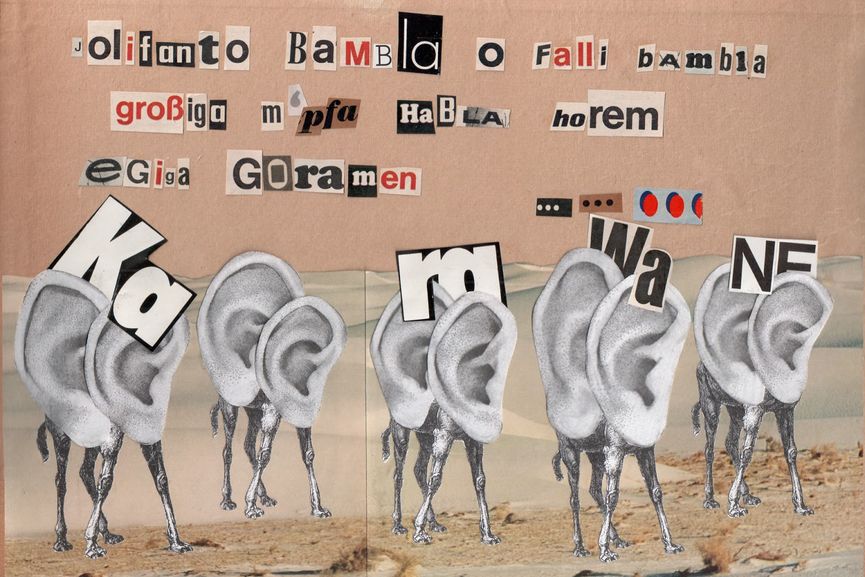
In response to the spontaneous nature of Dadaism, we were given a task to create one of these Dadaist-style poems.

- I was given 5 minutes and a sheet of a newspaper.
- I cut out random letter and words
- Placed these words in a box.
- I randomly took out a word one at a time and placed it on the page, to create a ‘nonsense’ poem.
Protests and Movements
Suffragettes –
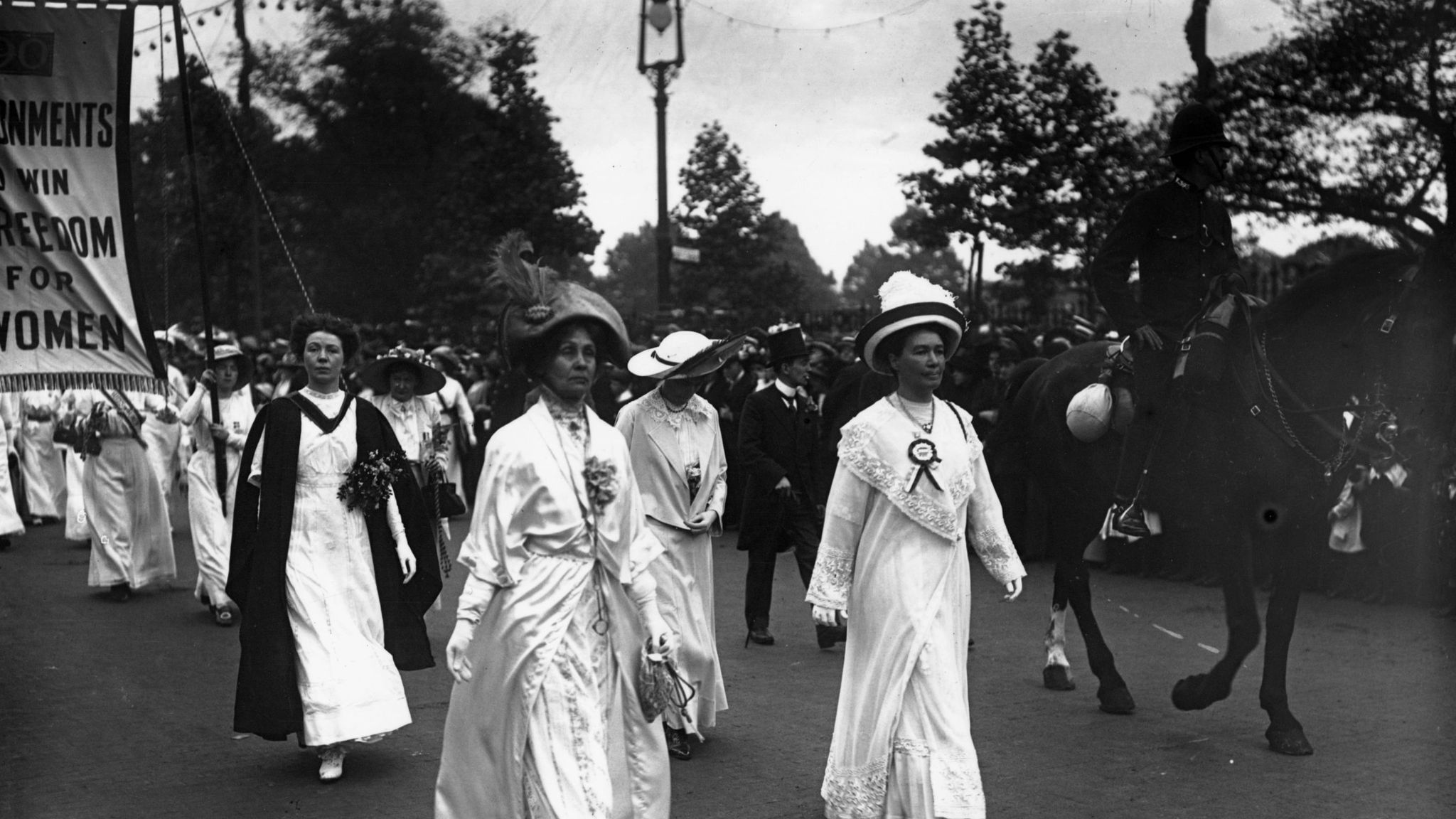
‘Fight on. God will give the victory’
Emily Wilding Davison
At the start of the 20th century there was a boom in support for women’s suffrage, signified under the banner ‘Votes for Women’. The women-only movement, ‘Women’s Social and Political Union’ (WSPU) was founded by Emmline Pankhurst in 1903 which pushed for equality for women more harshly as previous ‘peaceful’ tactics had not been successful, this approach was know as militant and In 1906, a reporter writing for the Daily Mail coined the term suffragette for the WSPU, from Suffragist, to belittle the women advocating women’s suffrage.
Unlike New Zealand who had granted the vote for all women over 21 years of age in 1893, enfranchisement for women in Britain still hadn’t occurred by 1903, leading to more militant actions being taken by the suffragettes.
Deeds, not words
WSPU motto
Emily Wilding Davison – (11 October 1872 – 8 June 1913)
Emily was a militant suffragette, she was arrested 9 times and went on hunger strike 7 times, being force-fed on 49 occasions. She unfortunately died at the 1913 Derby, when she walked onto the track during a race. On June 14th 1913, Emily’s body was transported from Epsom to London, inscribed on her coffin was ‘Fight on. God will give the victory’. Five thousand women formed a procession followed by many male supporters.
The Cat and Mouse Act 1913 – Some members of the Women’s Social and Political Union (WSPU, commonly referred to as suffragettes) had been imprisoned for acts of vandalism in support of women’s suffrage. In protest at being imprisoned, some of the suffragettes undertook hunger-strikes. The hunger strikers were force-fed by the prison staff, leading to a public outcry. The act was a response to the protestations. It allowed the prisoners to be released on licence as soon as the hunger strike affected their health; they then had a predetermined period of time in which to recover after which they were rearrested and taken back to prison to serve out the rest of their sentence. Conditions could be placed on the prisoner during the time of their release. One effect of the act was to make hunger strikes technically legal. The nickname of the act came about because of the domestic cat’s habit of playing with its prey, allowing it to temporarily escape a number of times, before killing it.
1918 – Women’s grant to vote if over 30 years old
1928 – Women of the age 21 and over could have the vote
Women’s vote locally – Was debated over several days, it was passed on 22nd May 1919 and entered into force on 12th July 1919.
Femen –
Femen is a feminist activist group in Ukraine intended to fight for and protect women’s rights. The organization became internationally known for organizing controversial topless protests against sex tourism, religious institutions, sexism, homophobia, and other social, national, and international topics. Founded in Ukraine, the group is now based in France.
Ultimately these protests were born out of the normalised misogyny that underpins Ukrainian society. Though this protest may contrast to many previous, feminist protests look different everywhere. Ideas behind protests such as this take the main focus or cause (in this case the female body) and use it as a device to torment the tormentor. In addition, as this form of protest is more radical it is likely to attract more attention from both everyday people and the media.
#Metoo –

In 2006, Burke founded the Me Too movement and began using the phrase “Me Too” to raise awareness of the pervasiveness of sexual abuse and assault in society. The phrase “Me Too” developed into a broader movement following the 2017 use of #MeToo as a hashtag following the Harvey Weinstein sexual abuse allegations.
Similar to other social justice and empowerment movements based upon breaking silence, the purpose of “Me Too”, as initially voiced by Burke as well as those who later adopted the tactic, is to empower women through empathy and solidarity through strength in numbers, especially young and vulnerable women, by visibly demonstrating how many women have survived sexual assault and harassment, especially in the workplace.
BLM –

In July 2013, the movement began with the use of the hashtag #BlackLivesMatter on social media after the acquittal of George Zimmerman in the shooting death of African-American teen Trayvon Martin 17 months earlier in February 2012.
Recently, the George Floyd protests are ongoing series of protests and civil unrest, mostly throughout America that are fighting for the equality of black lives. Polls in summer 2020 estimated that between 15 million and 26 million people had participated at some point in the demonstrations in the United States, making the protests the largest in U.S. history. Protests have continued as of October 2020.
The protests in America sparked other protests internationally, with the hashtag #BLM being used to raise awareness on multiple social-media posts. This cultural reckoning on racial injustice has also raised multiple questions about the federal governing in America. The systematic racism has been evident throughout American government for many years. For example the 13 Amendment was created in order to prevent slavery however, it only acts as a disguise for institutions to take advantage of certain people and cultures for profit (e.g the mass arrest of innocent black people in order to gain profit through prisons/ sentences).
Compare Suffragette movement to Femen Movement
Initially, both of these movements appear very different which is mostly due to contextual factors such as time, socio-economics, dominant ideologies and identity. The suffragette movement began in 1903, a time where enfranchisement or many other rights for women was viewed as irrelevant. On the other hand, founded by Ukrainian activist the Femen movement began in 2008. The key similarity between these two movements would be the continuation of a hegemonic struggle, suggested by Antonio Gramsci, whereby women are still seen as inferior in comparison to men. However, a more subtly similarity would be how the fight for equality for women is still being fought, over 100 years after the suffragette movement. Although the suffragette movement was massive and ultimately life changing for the role women played in society, it is evident that true equality is still yet to be reached. Furthermore, I believe that the suffragette movement was the catalyst which led to multiple other movements, for women as well as other identity political demographics such as the BLM movement.
Useful Sources –
Film Manifesto
Rolled words – Repetition, Everyday and Play
Gender Stereotypes
Snapshot through chronological order of the day with the female playing traditional female roles and male playing male roles
Visual – Use split screen, with female playing female role on left side – keeping the left side pink clothing themed, and then after male playing male role on right – keeping the right side blue clothing themed
Half way through film (45 seconds) do role reversal and have male playing female role still on left side, and then have the woman playing the male role on the right side – with both the outfit colours then also matching with the reversed roles
Audio – Using basic and somewhat plain background noises of what that specific scene would sound like – eg sound of tap running in a washing scene, and then when the scene cuts to short black screen the audio of the next scene then quickly blends into the upcoming scene
Title – ‘The elephant in the room’ relating to phrase of obvious point being ignored – the elephant being the role gender stereotpes still has in the modern day, the room as society.
Repetition – Use of snapshots following same format throughout with only slight difference of male/female actor
Everyday – following through a daily routine
Play – playing on stereotypes
Title –
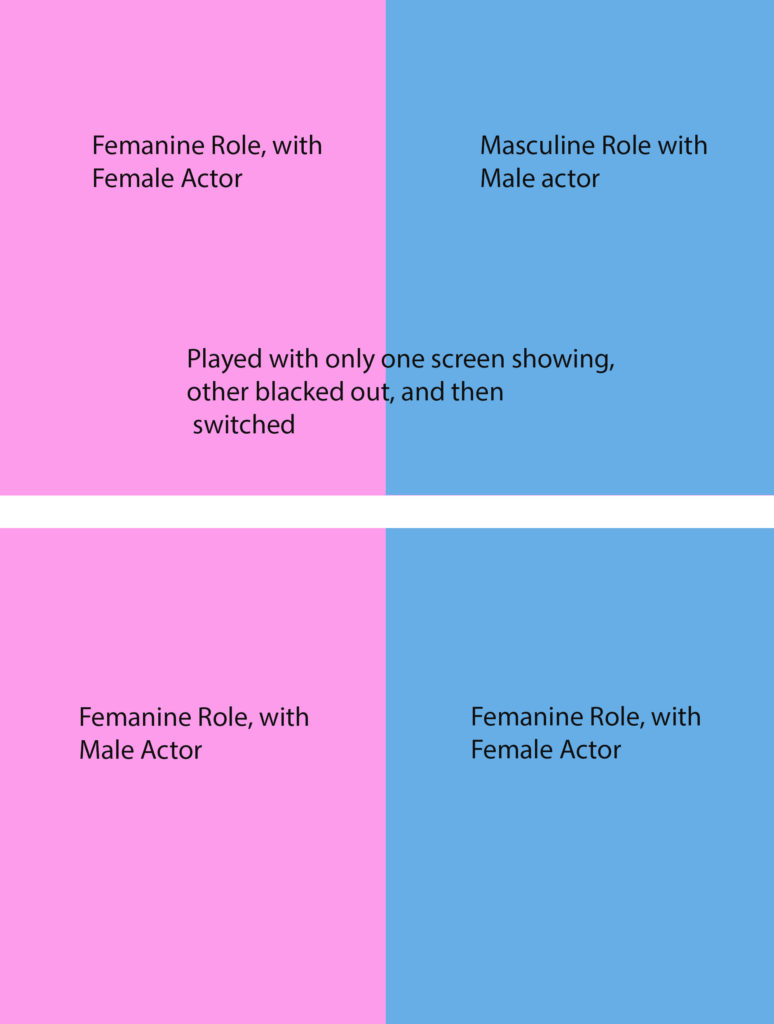

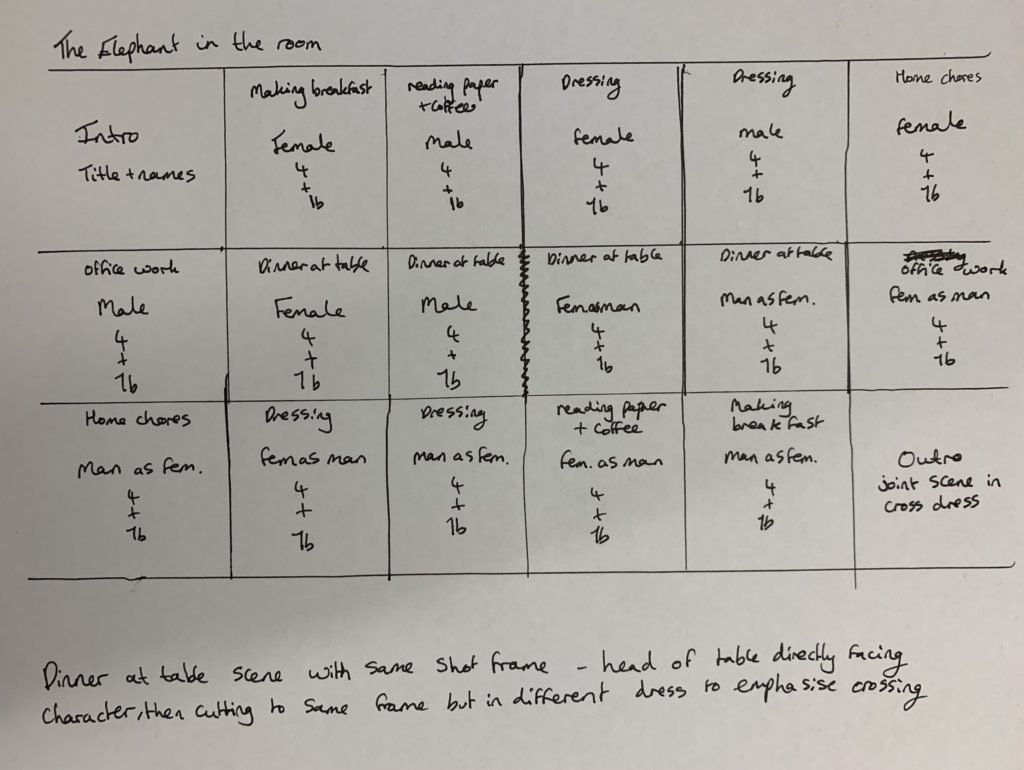
Protests and Movements
Historic movement
Women’s Suffrage movement

The term ‘Suffragette’ first came into use in 1906 to describe the women campaigning for their right to vote in the United Kingdom. Society at the time was highly patriarchal, where women’s rights were place on a par with servants, criminals and lunatics (three categories of people who were not given the right to vote).
The campaign against women’s suffrage had been going on since the 1860s by the Suffragists, who mainly advocated for middle class women. It was quickly escalated by Emmeline Pankhurst and her daughters (Sylvia and Christabel) who founded the Women’s Social and Political Union (WSPU) in 1903, separating the movement into two factions- peaceful Suffragists and militant Suffragettes.
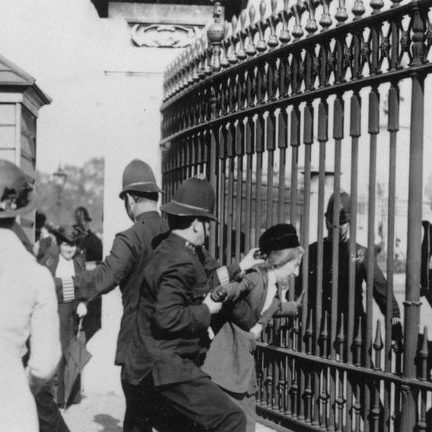
The WSPU was a women-only political movement and militant organisation arguing against women’s suffrage from 1903 to 1918. As these suffragettes became more militant, their actions and their treatment from the police also became more violent. The suffragettes begun their movement by encouraging working-class women to revolt, initially starting their protest by chaining themselves to the railings outside the Prime Minister’s property. The lack of response against this lead the suffragettes to take a more aggressive approach: Smashing windows, orchestrating arson attacks and causing riots at public demonstrations. Inevitably, many suffragettes were arrested for public disorder and give prison sentences, ranging from a couple of days to a number of months.

In response to these arrests, the imprisoned suffragettes often refused to pay their fines and went on hunger strike. This ultimately led to the Cat and Mouse Act which was passed in 1913, allowing for the early release of prisoners who had become so weak by hunger striking that they were at risk of death. However, this type of protest only proved successful for a limited time. Authorities implemented force-feeding into the prisons, whereby women who refused to eat were restrained while a tube was forced down their throat or up through their nose.
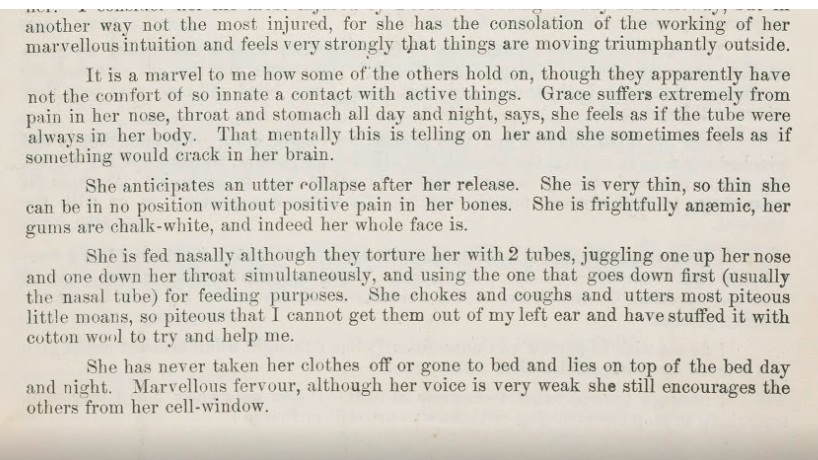
One of the most fateful incidents during the movement was the death of Emily Wilding Davidson at the Epsom Derby. The accident was broadcast live in which Davidson could be seen running out in front of the King’s horse in an attempt to attach a flag to it’s bridal. The act had failed horribly. Davidson was trampled by the horse and died four days later due to her extensive injuries. She became a martyr for the suffragettes and many applaud her for her commitment to the movement and admire her for her bravery.
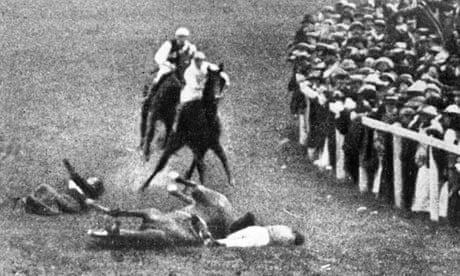
“It is hugely significant as a moment in history, a moment that absolutely sums up the desperation of women in this country who wanted the vote.”
When World War One commenced in 1914, the suffragette movement was suspended. However, progress was made in 1918, where women over the age of 30 were given the right to vote if they met certain property qualifications. Although it was a breakthrough, women’s rights were still not equal to those of men, who were given the right to vote at the age of 21. Furthermore, the Parliament (Qualification of Women) Act 1918 was passed, allowing women to be elected into Parliament. It took another decade before women were allowed to vote at 21 but the Representation of the People Act was passed in 1928, providing women with the same voting rights as men in the United Kingdom.
Modern Movement
The ‘Me Too’ Movement
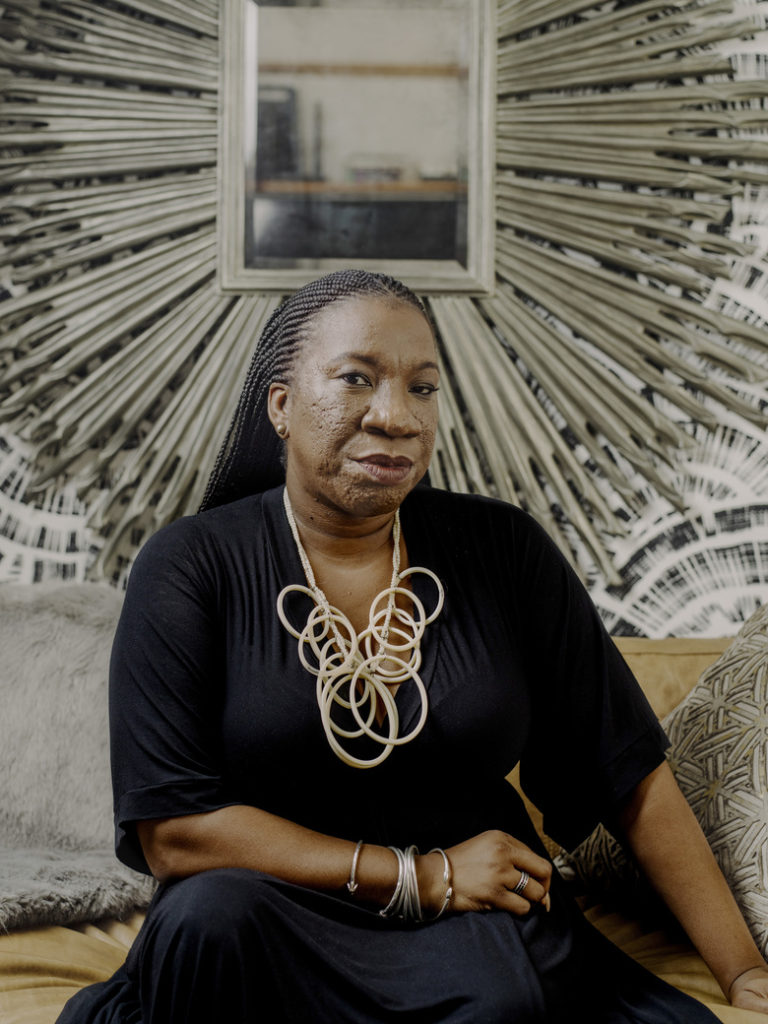
The Me Too movement is a modern, social movement against sexual abuse and sexual harassment towards women.
This particular movement was established in 2006 by American social activist Tarana Burke, in an effort to publicize allegations of sex crimes which had been committed by powerful and prominent men.
Burke (pictured on the left) first used the phrase ‘me too’ on the online platform MySpace to highlight the contingency of sexual harassment, particularly as it targeted women of colour. The phrase came about after she felt unable to respond to a 13-year-old girl who opened up about being sexually assaulted. Burke said she later wished she had simply told the girl: “Me too”.
It Focuses on the experiences of sexual violence survivors, has received a large response as sexual harassment and sexual assault impact the women in our society every day.
The movement became relatively prominent in 2017, when numerous high-profile actresses opened up about the sexual harassment they had experienced in the film industry. Many of these actresses spoke out about the harassment received from the film producer Harvey Weinstein. Alyssa Milano, specifically, acted as a catalyst for the movement after turning the phrase into the well known hashtag #MeToo.
Following this, the movement has provided solidarity for those who have experienced harassment of this sort by showing the world just how prominent sexual harassment is in our society and the movement helps to make these survivors aware that they’re not alone.
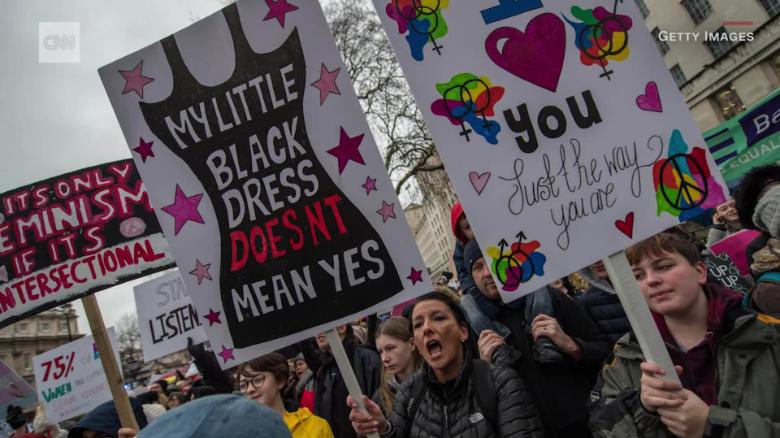
The media coverage of this movement has uncovered some heartbreaking statistics:
- In France, a person who makes a sexual harassment complaint at work is reprimanded or fired 40% of the time, while the accused person is typically not investigated or punished.
- In the United States, a 2016 report states that although 25–85% of women say they experience sexual harassment at work, few ever report the incidents, most commonly due to fear of reprisal.
- Evidence shows that in Japan, as little as 4% of rape victims report the crime, and the charges are often dropped half the time.
The movement has had a large global impact. After Milano tweeted #MeToo on October 15, 2017 it was used over 200,000 times by the end of the day and tweeted almost 500,000 times in 24 hours. Additionally, on Facebook, the hashtag was used over 4.7 million times on over 12 million posts in the first 24 hours. This led to many celebrities opening up about their experience of harassment, including men such as Terry Crews and James Van Der Beek.
Suffragets and Dadaism
/https://public-media.si-cdn.com/filer/2a/0c/2a0c3b0b-a675-40f2-9e25-c479cab30cbd/women_stand_in_gutter_for_a_poster_parade_organised_by_the_womens_freedom_league_to_promote_the_suffrage_message_c_museum_of_london.jpg)
A suffragette was a member of an activist women’s organisation in the early 20th Century who, under the banner ‘Votes for Women’, fought for the right to vote in public elections, known as women’s suffrage.
It was formen in 1903, by Emmeline Pankhurst, which engaged in direct action and civil obedience. This meant that the suffragets usually engaged in heckling politicians, trying to storm parliament, being sexually assaulted during battles with the police, chaining themselves to railings, smashing windows, setting fire to post boxes and buildings, setting bombs, and faced enormous anger and ridicule from the media. This was a shock factor tactic in order to get people’s attention and to urge politicians to change the rights for women as soon as possible.
The suffraget campaign was suspended when WW1 broke out in 1914. After the war however, the Representation of People Act 1918 gave the vote to women over the age of 30 who met certain property qualifications. Ten years later, wome gained electoral equality with men when the Representation of People (Equal Franchise) Act 1928 gave all women the ability to vote at age 21.
This can be compared in a way to BLM (Black Lives Matter). Black people specifically have been scrutinized by police, mainly in America, however there has been examples of this kinds of prejudice in the UK also – police are making a stereotype against black people and harming them – sometimes to the point of death – due to the stereotype that is held by the police. This is unfair and is a form of discrimination held against them purely due to their skin colour. This is the same for women in the early 20th Century, because they were women, they were seen as unfit to vote and

were stereotyped into being less educated, less intelligent, less dominant etc. Because of their gender, their rights were taken away from them. The types of protests can also be compared, BLM and Votes for Women used violent, shock tactics in order to gain attention from world leaders and politicians since no one was listening or paying attention any other way. During BLM protests, riots were held, looting took place and fires were ignited.

Dadaism was a movement with explicitly political overtones and was a reaction to senseless slaughter of the trenches of WW1. It essentially declared war against war, countering the absurdity of the establishment’s descent into chaos with its own kind of nonsense.
Popular Dada artists include: Marcel Duchamp, Francis Picabia, George Grosz, Otto Dix, John Heartfield, Hannah Hoch, Max Ernst, Tristan Tzara, Richard Hulsenbeck and Marcel Janco.
There is some controversy over where Dada first originated. Some believe that the movement first developed in the Cabaret Voltaire, an avant-garde nightclub in Zurich, others claim a Romanian origin. Dadaism is often characterised by humor and whimsy, tending towards the absurd. This kind of attitude was used as a satirical critique of the prevailing societal and political systems . to which the onslaught of WW1 was largely attributed to.
The name Dada is one derived from nonsense and irrationality. In some languages in means ‘yes, yes’ as a parody of the population’s senseless obedience to authority, whilst in others it has completely different meanings or connotations.


CaseStudy- Claude Cahun
Context
Claude Cahun (born Lucy Renee Mathilde Schwob) was an androgynous, surrealist and activist photographer, widely known for her enigmatic self-portraits, in which Cahun presented herself as many different personas. As a teenage Lucy Schwob, she rebelled against conventional ideas of beauty by shaving her head and wearing masculine clothing. She changed her name to the infamous and gender-neutral tag ‘Claude Cahun’ in 1917. Later on in her life, she displayed resistance to the German forces during the WWII occupation of Jersey.
Her resistance against these forces was admirable and still is today, especially as she came from a Jewish family. Alongside her partner, Cahun resisted against these troops and created a persona referred to as ‘Der Soldat Ohne Namen’ (‘The Soldier Without a Name’) in which she presented this persona as an unknown German soldier whose sole intent was to inspire rebellion within the army. She wrote leaflets pointing out the idiocy of war and ridiculing the actions of the German officers. These were either posted through the windows of German cars or left in cigarette packets, hoping that someone would pick them up.
However, after four years, Cahun and Moore were caught and arrested. They were then both sentenced to 6 years imprisonment and later death for inciting rebellion.
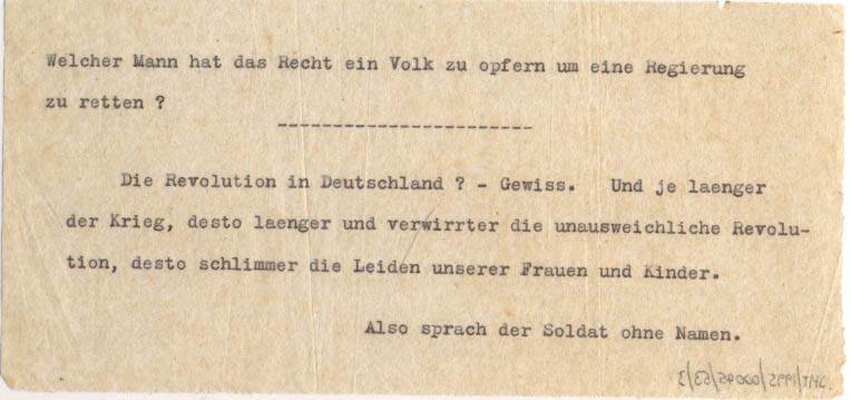
Cahun’s work
Cahun’s work mainly explored gender identity and the subconscious mind. During the 1920s Cahun produced an astonishing number of self-portraits in various acts such as a pilot, doll, bodybuilder, vampire, angel, and Japanese puppet. A large number of her portraits, feature Cahun making direct eye contact with the camera, with her shaven head and often revealing only head and shoulders. This resulted in photos where the viewer could not clearly identify and define Cahun’s gender by the distinguishing features that would have otherwise been visible to the audience.
For full-body portraits, Cahun often posed herself with purpose. Theatre became an important feature of Cahun’s work, as she aimed to avoid displaying any behaviour that could be associated with a gender and attempted to create images that blurred any possible gender indicators from the viewer.
Photo Analysis
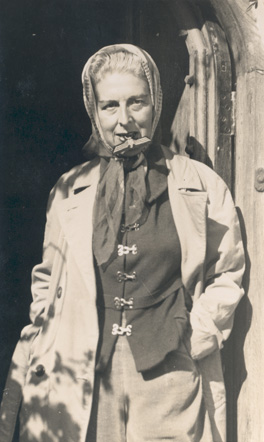
Taken during the Jersey occupation, this portrait depicts Chaun dressed as an old woman. This guise is significant due to her rebellious role in the occupation. Cahun and her partner Moore disguised themselves as old women and often travelled to the town of St Helier, where they attempted to humiliate the German occupying forces through the use of notes and letters written by what they referred to themselves as ‘der Soldat ohne Namen’. The portrait shows Cahun holding a nazi cross between her teeth.
The treatment of this cross is significant to the portrait. The act of gripping this nazi symbol between her teeth acts as an act of defiance against the German officers, in turn stripping the cross of any symbolic power it holds as well as rendering it insignificant, as Cahun believed the acts of war were completely nonsensical and unjust. Her slight smirk and bold gaze past the camera implies the presence of a person or thing that has captured Cahun’s attention. This creates ambiguity. The viewer may question who she is glancing at. Perhaps it is one of the German officers themselves, this potentiality gives the viewer the idea that Cahun is fearless in her resistance. Additionally, her pose is confident. The positioning of her hands in her pocket also acts as a rebellion against the societal ideals of women during that era. The pose is relaxed and comfortable, lacking the elegance and grace expected by women at the time.
The lighting within the image is also significant. Taken in bright daylight, it amplifies the impression that Cahun is unafraid of displaying her rebellion. She would have been in public view, given the background and shadow of foliage suggests she is outside. This unrestricted display of discontent toward the German forces is commendable and extremely brave for someone of that time, especially considering her Jewish background and social position as a woman at the time.
Identity politics and culture wars
Identity politics is a currently controversial political outlook. Oppose to the philosophy of individualism and the approach of implementing broad changes across the board, identity politics takes the view of grouping certain demographics together. These groups will be exclusively part of socio-political legislation, schemes and laws as well as cultural changes accepted by the majority of the public. Identity politics is a big talking point in the U.S.A. A huge element of this is based on race. There is a culture in America that normalizes the frequent use of labels (e.g. African American). Contextually, it was only in the 1960’s/1970 the black population became equal in the eyes of the law and government. This is a recent date relative to the time scale of politics and culture. This means that after the law is finally ‘fixed’ the next step is for society and culture to catch up. Most people would argue this is still taking place today in America. For example, there is still deep rooted racism in the police force, so deep that most of the police officers are unaware of their wrong doings. The geology of inner city suburbs also show such a divide of who is in poverty and who is not. These factors are derived from the more serious problems from the past (e.g. slavery) that have trickled down into these problems that are still prevalent. This is where identity politics comes in. People believe that there should be more implementation of support to certain social groups that have been oppressed or still to this day are being oppressed. On the surface this ideology seems to be an obvious morally correct stance. However there are other arguments that are made regarding this, one of them being that it may exclude the idea of the individual , thus forming unnecessary stereotypes and intensified political divide.

With the world becoming increasingly globalized, there has been an increase in migration and movement in labor forces. This has resulted in the already diverse world becoming even more diversified in different cultures. Not only immigration but already existing cultures that originated up to a century ago and cultures that have always existed to a certain extent like the LGBT community are also involved in the diversification of culture. These sections of the the population have spoken up during recent decades, especially, as well as there opposing sides. This creates culture war. Even though there may be a lack of tanks and artillery on the battlefield, the issues are just as serious and there is still a presence of violence. The culture wars are closely intertwined with identity politics. Culture wars is what sparks the flame for protests and rebellion on the platform of identity politics. It can be a dangerous game to play when groups of the population become tribal and aggressive to other ‘tribes’ even though it is not themselves that gave them or the opposing ‘their’ labels. This problematic factor provokes the question whether identity politics is the right way forward or at least where the line should be drawn in the sand.



